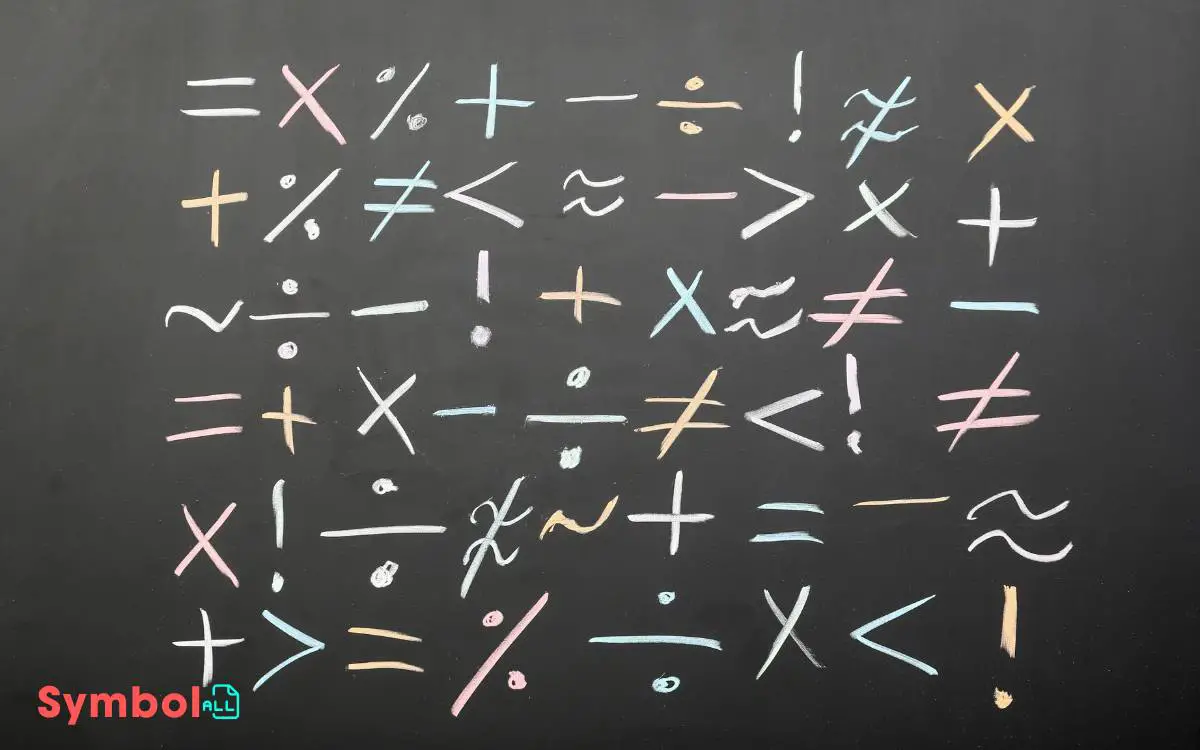Mathematical Symbols
Mathematical symbols provide you with a concise and clear method to express numerical and algebraic concepts.
These symbols have evolved from basic arithmetic signs to more complex notations used in algebra and calculus.
For instance, ‘+’ and ‘−’ simplify expressions of addition and subtraction, while symbols like ‘×’ and ‘÷’ represent multiplication and division.
In algebra, variables like (x) and (y) help generalize relationships, and the equals sign (=) denotes equality.
Calculus employs specialized symbols, such as (\int) for integration and ( rac{d}{dx}) for differentiation, essential in analyzing dynamic systems. Understanding these symbols opens up further insights into more intricate mathematical areas.
Mathematical Symbols & Meaning
| Symbol | Meaning |
|---|---|
| + | Addition |
| – | Subtraction |
| × | Multiplication |
| ÷ | Division |
| = | Equality |
| ≠ | Inequality (not equal) |
| < | Less than |
| > | Greater than |
| ≤ | Less than or equal to |
| ≥ | Greater than or equal to |
| ∞ | Infinity |
| ∑ | Summation (sigma) |
| √ | Square root |
| ∛ | Cube root |
| π | Pi (approx. 3.14159) |
| θ | Theta (angle) |
| Σ | Capital sigma, used in series notation |
| Φ | Phi, often used in mathematics and physics |
| ∆ | Delta, often used to denote change or difference |
| ∇ | Nabla, gradient operator |

Key Takeaways
- Mathematical symbols are essential for expressing concepts efficiently in arithmetic, algebra, and advanced calculus.
- Basic arithmetic operations use symbols like ‘+’, ‘-‘, ‘×’, and ‘÷’.
- In algebra, variables are represented by letters such as (x), (y), and (z), with operations denoted by familiar arithmetic symbols.
- Advanced notations include (\int) for integration and ( rac{d}{dx}) for differentiation, crucial in calculus.
- Uncommon symbols like (\aleph) and (
abla) are used in specialized areas such as set theory and vector calculus.
Origins of Mathematical Symbols
The development of mathematical symbols began as a practical need to express mathematical concepts clearly and efficiently.
You must consider the widespread use of symbols as a transformative step from the rudimentary counting systems of ancient civilizations to the complex abstractions used today.
Initially, simple notations were used by the Babylonians and Egyptians, evolving into more sophisticated systems as mathematical understanding deepened.
Symbols weren’t merely shortcuts; they represented a fundamental shift in thinking, allowing for the abstraction and generalization that are central to modern mathematics.
This evolution was marked by gradual adoption and adaptation across different cultures, which refined and expanded the symbolic repertoire, setting the stage for future mathematical advances.
Basic Arithmetic Symbols
Building on historical foundations, you now encounter basic arithmetic symbols, which streamline the expression of addition, subtraction, multiplication, and division.
These symbols form the core of elementary mathematical operations and are pivotal for further mathematical understanding.
Here’s a systematic overview:
| Operation | Symbol | Example |
|---|---|---|
| Addition | + | 5 + 3 |
| Subtraction | – | 5 – 3 |
| Multiplication | × | 5 × 3 |
Each symbol serves a distinct function: ‘+’ denotes addition, enhancing quantitative value; ‘-‘ indicates subtraction, signifying reduction; and ‘×’ signifies multiplication, reflecting scaling or repeated addition.
Mastery of these symbols and their operations is essential, as they’re the building blocks for more complex mathematical concepts.
Understanding their precise application empowers you to tackle broader numerical challenges effectively.
Symbols in Algebra Explained
You’ll now explore algebraic symbols, which are essential tools for expressing general mathematical relationships and solving equations systematically.
In algebra, variables represented by letters such as (x), (y), and (z) are placeholders for unknown values and can represent numbers in equations and formulas.
Symbols like (+), (-), (imes), and (\div) denote addition, subtraction, multiplication, and division, respectively.
Moreover, the equal sign ((=)) asserts that two expressions represent the same quantity. Powers are indicated by exponents, for example, (x^2) means (x) squared.
Parentheses (()) are used to clarify order of operations, ensuring operations within them are performed first. Understanding these symbols helps you manipulate and solve algebraic expressions effectively.
Advanced Calculus Notations
Delving into advanced calculus, you’ll encounter specialized notations like (\int) for integration and ( rac{d}{dx}) for differentiation, which are pivotal for analyzing and solving complex mathematical problems.
As you progress, you’ll use these symbols to represent the accumulation of values and rates of change, respectively.
The integral sign, (\int), symbolizes the summation of infinitely small quantities, a concept foundational in areas like physics and engineering.
On the other hand, the differentiation operator, ( rac{d}{dx}), is used to describe how a function changes at a particular point.
Mastering these notations allows you to handle dynamic systems and predict variations, making them indispensable tools in your mathematical toolkit.
Uncommon Mathematical Signs
While familiar symbols like (\int) and ( rac{d}{dx}) are key in calculus, exploring less common mathematical signs can further expand your understanding of complex concepts.
Explore symbols like (\aleph) (aleph), used in set theory to denote the cardinality of infinite sets. It’s essential for grasping the nature of different sizes of infinity.
The symbol (
abla) (nabla), though occasionally seen, plays a central role in vector calculus representing the gradient, divergence, and curl operations.
Understanding these signs isn’t just academic; they’re practical tools in theoretical physics and engineering.
Familiarizing yourself with them enhances your mathematical literacy and equips you to tackle more sophisticated topics in your studies.
Conclusion
As you’ve journeyed through the domain of mathematical symbols, you’ve explored the foundational currents of arithmetic and delved into the complex waves of algebra and calculus.
Each symbol, a concise beacon of knowledge, guides your understanding and problem-solving precision. Embrace these tools, for they’re keys to accessing the universe’s most intricate puzzles.
Continue to investigate, analyze, and apply these signs; they’re your steadfast companions on the rigorous path of mathematical discovery.
